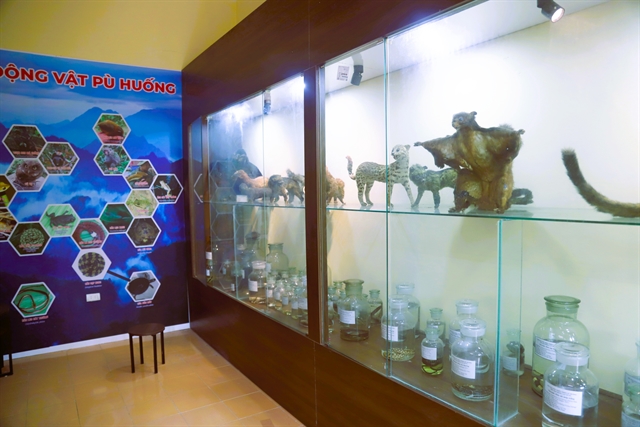 Expat Corner
Expat Corner
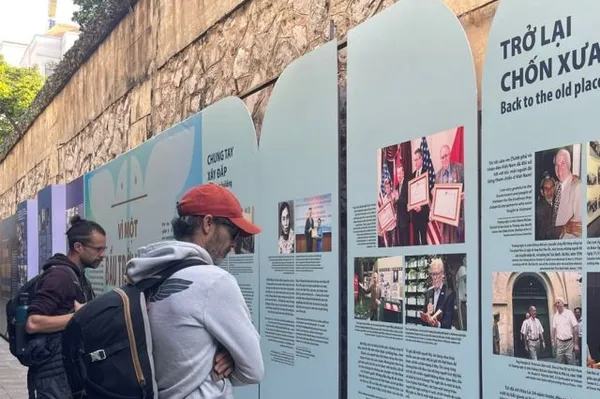
By Hương Thu
After over 15 years living and working in HCM City, American professor Annette M. Kim has fallen in love with the local land and people.
Kim and her colleagues have conducted hundreds of interviews and taken thousands of photos to confirm that sidewalks in HCM City make it different to other cities in the world.
“How I see it is that Sài Gòn has a lot to teach the world,” she told Việt Nam News. “Rapidly growing cities around the world are grappling with how to plan and manage public space when so many people are migrating to urban centers and cities are becoming denser than ever.

|
| Prof Kim (middle) with architect Lê Nguyễn Hương Giang (left) by a street vendor on a downtown HCM City's sidewalk. Photo Courtesy of Hoàng Thạch Vân |
“Until recently most urban designers focused on large monumental public spaces like squares and plazas.
“But, the humble sidewalk is actually one of the most important spaces that people use every day, and where people interact regularly and see each other. It is also a place that could potentially support the livelihood of large numbers of people in a way that provide benefits to society."
What she found in her research is that Sài Gòn has so much variety in different parts of the city when it comes to sidewalk life.
"The thing that was really surprising was how much this narrow sidewalk space could be shared in Sài Gòn, supporting so many different kinds of activities.
“The sharing was only possible because of the high degree of sociability in Sài Gòn – people are chatting and negotiating all the time. They also viewed people like vendors as fellow citizens. Of course, people get annoyed but still they tolerated so much and did not feel so entitled.”

|
| A barber's at the sidewalk. Photo Courtesy of Holly Durso |
In their interviewing with hundreds of people, it was common for vendors to say that the property owners, whether they are homeowners or shopkeepers of small businesses, actually aided them, giving them free water and electricity to use in their operations, or storing their goods overnight for a small fee. Usually, property owners in other cities are the most vehement in clearing off sidewalks.
Kim first came to Việt Nam in 1996 as a graduate student from the United States. She accompanied her professor on a consulting project for CT&D who was just starting to develop Saigon South.
“I was so struck by how gracious people were,” she recalled. “I remember we woke up a family napping in a one-room house with wooden floor. They sent their child out to get me a drink, which at that time was a soda in a plastic bag tied up with rubber band with a straw stuck in it.”
She had a wonderful time and decided this is where she wanted to do her dissertation research.
Kim and her colleagues have worked for many years at the Spatial Analysis Lab of University of Southern California (SLAB) to gather data on sidewalks from documents, statistics, urban planning and photos as well as academic documents of historians from various periods in the past.
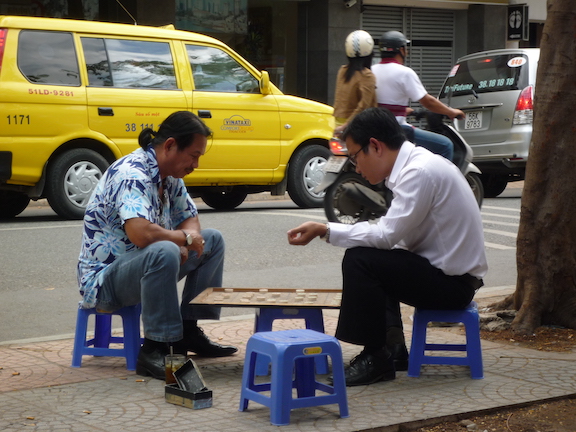
|
| Sidewalks host various community activities. Photo Courtesy of Holly Durso |
Moving stories
Kim remembers a story from a coconut water vendor in the street.
“One day, the coconut water vendor was sitting in the street, just off the sidewalk’s edge. A policeman had told them if they stayed there he wouldn’t have to clear her off since she would technically not be on the sidewalk," Kim recalled.
"It was actually more dangerous for them to be in the street which was ironic since one of the reasons for the sidewalk clearance policies was to help the flow of traffic.
But, he had known this vendor since he was a child when he used to buy drinks and candy from her so he couldn’t help but be sympathetic to her.”
The story showed Kim how democratic people are in the streets of Việt Nam. People are always talking to each other, making their case. They have job titles but that is not our only identity or understanding of the world. “Part of what I experience on the sidewalks of Việt Nam is eye-to-eye acknowledgement of each other as human beings,” she said. “I think it may be starting to disappear more now as inequality grows and people are becoming more spatially separate, but when I lived there in the 1990s and 2000s, people of different classes, gender, ages, etc. would talk to each other.”
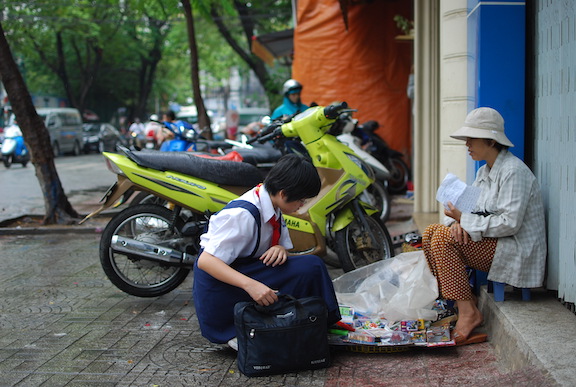
|
| Sidewalks are where many people live. Photo Courtesy of Tiffany Chu |
Indispensable sidewalks
What she noticed in researching Sài Gòn is that these sidewalk controversies have been going on since the French colonial days when they first built the sidewalks.
And going through Vietnamese policies since the 1960s, the same kinds of cycles keep happening where there will be a period of more intense sidewalk clearing to create more order but then a relenting to allow people to make a living, and because the numbers are so overwhelming, it is impossible to keep up enforcement for long, at least not until there can be better employment opportunities.
“Throughout the city, I found it amazing that there has been a lot of flexibility and experimentation because people are trying to be reasonable and pragmatic that there are so many bodies in this narrow space,” she said.
Kim thinks that the global COVID-19 pandemic has made people see city living in a new way. Living with lockdowns and the suffering of small businesses, the critical importance of outdoor public space has become clearer to many.
“In general, I think it would make sense to acknowledge and work with the actual enforcement situation and allow local authorities to experiment and share their experience,” she said.
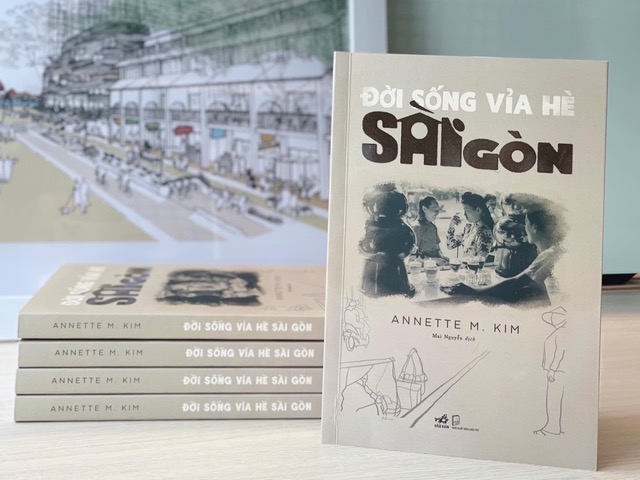
|
| The book by Annette M. Kim and colleagues. Photo Courtesy of the professor |
She often thinks about how many American cities now look more like Sài Gòn.
“Because of COVID, in a matter of months, city governments de-regulated so much and allowed especially restaurants to take over parts of the sidewalk and parking lots without a lot of paperwork or waiting time, and American people are enjoying eating outdoors near the street and feel like it’s safer as COVID mutations continue,” Kim said.
These are still temporary pilot projects at this time but people are experiencing new spatial paradigms.
“At the same time, homelessness has also increased in major American cities with people setting up tents on the sidewalks or living out of vans parked on the street,” she said. “People are frustrated seeing this and trying to regulate this out while others are more sympathetic. So, the contest for public space is intensifying like it has in other parts of the world,” Kim said.
The book titled Đời Sống Vỉa Hè Sài Gòn by Kim and her colleagues has been published offering a panorama on the special public cultural space in HCM City and solutions to develop urban areas.
“I and my Vietnamese friends including urban planner Nguyễn Đỗ Dũng and architect Lê Nguyễn Hương Giang want to do something for Sài Gòn as I have got too many valuable experiences here,” she said.
Annette M. Kim is a Professor in public administration and urban planning from the Massachusetts Institute of Technology. She is the founder of the SLAB of University of Southern California.
Her Ph.D thesis, completed in 2002, was on the urban land development of HCM City. VNS



